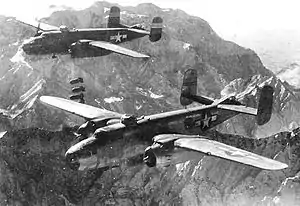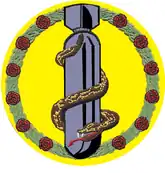381st Bombardment Squadron
The 381st Bombardment Squadron is an inactive United States Air Force unit. It was last assigned to the 310th Bombardment Wing at Schilling Air Force Base, Kansas, where it was inactivated on 25 March 1965.
| 381st Bombardment Squadron | |
|---|---|
 B-25 Mitchells of the -310th Bombardment Group attacking the Brenner Pass in 1944 | |
| Active | 1942-1945; 1947-1949; 1952-1965 |
| Country | |
| Branch | |
| Role | medium bomber |
| Engagements | Mediterranean Theater of Operations[1] |
| Decorations | Distinguished Unit Citation Air Force Outstanding Unit Award[1] |
| Insignia | |
| 381st Bombardment Squadron emblem[note 1][1] |  |
| 381 Bombardment Sq emblem (World War II)[2] |  |
History
World War II
Activated in mid-1942 as a North American B-25 Mitchell medium bomber squadron, it was trained by the Third Air Force in the southeastern United States. The squadron deployed initially to England in September 1942 and flew some missions under the VIII Bomber Command over German-occupied France, attacking enemy troop formations, bridges and airfields. It was part of Operation Torch, the invasion of North Africa in November 1942, being deployed to the new Mediterranean Theater of Operations, and was assigned to the Twelfth Air Force in French Morocco in November. In North Africa, the squadron engaged primarily in support and interdictory operations, bombing marshalling yards, rail lines, highways, bridges, viaducts, troop concentrations, gun emplacements, shipping, harbors and other targets in North Africa.
The squadron also engaged in psychological warfare missions, dropping propaganda leaflets behind enemy lines. It took part in the Allied operations against Axis forces in North Africa during March–May 1943 and the reduction of Pantelleria and Lampedusain islands during June. Squadron personnel were also involved in the invasion of Sicily in July, the landing at Salerno on the Italian mainland in September, the Allied advance toward Rome during January–June 1944, the invasion of southern France in August 1944 and the Allied operations in northern Italy from September 1944 to April 1945.
It was inactivated in Italy after the German capitulation in September 1945.
Reserve operations
The squadron was reactivated as part of the reserve in 1947, it is unclear whether or not the squadron was manned or equipped. It was inactivated later that year.
Strategic Air Command
It was reactivated on 28 March 1952 as a Strategic Air Command (SAC) squadron,[1] although it did not become operational until 4 April.[3] receiving Boeing B-29 Superfortress bombardment training from the 90th Bombardment Wing between April and August 1952. The squadron acted as a training unit until 1954 when it replaced the propeller-driven B-29s with new Boeing B-47E Stratojet swept-wing medium bombers. These aircraft were capable of flying at high subsonic speeds and were primarily designed for penetrating the airspace of the Soviet Union. By the early 1960s, the B-47s were considered to be reaching obsolescence, and were being phased out of SAC's strategic arsenal. They were sent to the Aerospace Maintenance and Regeneration Center at Davis-Monthan Air Force Base, Arizona in early 1965; the unit became non operational on 25 February,[3] and was inactivated on 25 March.
Lineage
- Constituted as the 381st Bombardment Squadron (Medium) on 28 January 1942
- Activated on 15 March 1942
- Redesignated 381st Bombardment Squadron, Medium c. 30 August 1943
- Inactivated on 12 September 1945
- Redesignated 381st Bombardment Squadron, Light on 11 March 1947
- Activated in the reserve on 9 August 1947
- Inactivated on 27 Jun 1949
- Redesignated 381st Bombardment Squadron, Medium on 15 March 1952
Assignments
- 310th Bombardment Group, 15 March 1942 –12 September 1945
- 310th Bombardment Group, 9 August 1947 – 27 June 1949
- 310th Bombardment Wing (later 310th Strategic Aerospace Wing), 28 March 1952 – 25 March 1965[4][3]
Stations
|
|
References
Notes
- Explanatory notes
- Approved 7 March 1956
- Citations
- Maurer, Combat Squadrons, pp. 470-471
- Watkins, pp. 80-81
- Ravenstein pp. 158-159
- Lineage through May 1963 in Maurer, Combat Squadrons, pp. 470-471
- See Ravenstein pp. 158-159 (dates assigned to 310th Wing).
Bibliography
![]() This article incorporates public domain material from the Air Force Historical Research Agency.
This article incorporates public domain material from the Air Force Historical Research Agency.
- Maurer, Maurer, ed. (1983) [1961]. Air Force Combat Units of World War II (PDF) (reprint ed.). Washington, DC: Office of Air Force History. ISBN 0-912799-02-1. LCCN 61060979. Retrieved 17 December 2016.
- Maurer, Maurer, ed. (1982) [1969]. Combat Squadrons of the Air Force, World War II (PDF) (reprint ed.). Washington, DC: Office of Air Force History. ISBN 0-405-12194-6. LCCN 70605402. OCLC 72556.
- Ravenstein, Charles A. (1984). Air Force Combat Wings, Lineage & Honors Histories 1947-1977 (PDF). Washington, DC: Office of Air Force History. ISBN 0-912799-12-9. Retrieved 17 December 2016.
- Watkins, Robert A. (2009). Insignia and Aircraft Markings of the U.S. Army Air Force In World War II. Vol. IV, European-African-Middle Eastern Theater of Operations. Atglen,PA: Shiffer Publishing, Ltd. ISBN 978-0-7643-3401-6.
